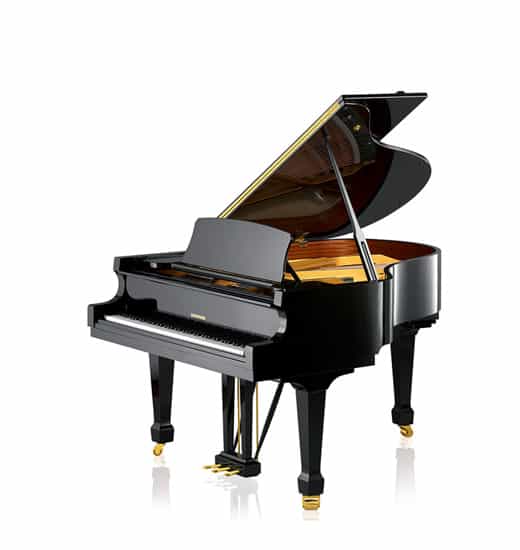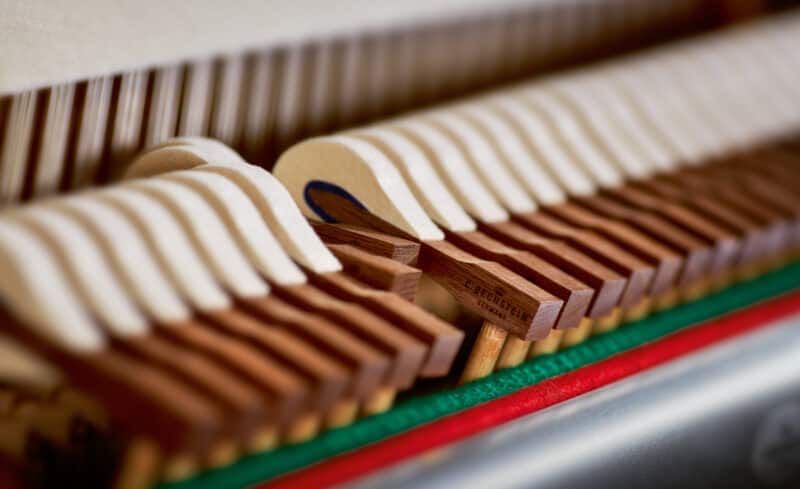The W. Hoffmann series of pianos from the C. Bechstein Europe parent company presents many choices for today’s piano buyer. The Vision series is the entry point to the line and offers a modern, handcrafted European piano from the Czech Republic for about the price of a professional Japanese instrument, while the top-end Professional series serves as a lower-cost near copy of the German C. Bechstein Academy series.
Unlike the modernized scale designs of the Vision and Professional series, the Tradition series is built with the intention of capturing the essence of the great German pianos of the past.
Today, we’re going to be looking at the middle model in the Tradition line as we dive into the W Hoffmann T177 5’10” grand piano. We’ll be focusing on the sound, action as well as some design specifics. We’ll get started with some background information on the piano.
W Hoffmann T177 – Background Information

Made in the Czech Republic
The first thing to know about the W Hoffmann T177 is that it is a 100% European piano, made by C. Bechstein in the town of Hradec Králové in the Czech Republic. This is important to clarify because many so-called European grand and upright pianos are actually primarily built in Asia.
There’s of course nothing wrong with that, but this is something that people can be quite sensitive about so it’s important to understand that when talking about a W. Hoffmann Tradition or Professional, we’re talking about a completely European acoustic piano.
The Vision by contrast uses strung-backs imported from Asia, but all of the assembly is done in the Czech Republic. Certain other pianos may feature a number of components, but all production and assembly occur in Asia.
Tradition vs Professional Series
The Professional series is the most expensive line from W. Hoffman while The Tradition costs a little bit less and sits in the middle of the pecking order. There’s no question that the T177 sounds quite different from a Professional series piano, but interestingly, it’s not really accurate to call the Professional series superior.
They’re much more of a parallel product with two different design and tonal philosophies and both exemplify European quality. The T177 produces a warmer sound with a rounder attack than what the Professional series is delivering, which has a very specific bell-like tone.
The Professional series is also very forward in terms of its treble bias. In contrast, the Tradition series is darker, with an almost Shigeru Kawai-esque tone that manages to be warm and dark, yet colorful at the same time.
With some context out of the way, let’s move on to some specifics with regard to the T177’s design and features.
W Hoffmann T177 – Design Features
Duplex Scale
The T177 is equipped with several features which are important to highlight. For one, it’s got a duplex scale which means that there are metal fulcrums behind the top treble sections to give the strings extra speaking length which adds to the top-end harmonics.
Most higher-end pianos feature duplex scaling as it’s a staple of premium piano making.
Solid White Spruce Soundboard
The T177 features a solid spruce soundboard – white spruce specifically that is grown in the Alpine region of Europe. This soundboard is not to the level of what you’ll find in a C. Bechstein Concert series, but this is still a very high-quality soundboard of slow-growth mountain spruce.
Hardwood Rim
Another key feature of the T177 is the fairly thick hardwood rim. It’s not hard rock maple as is somewhat common in the price range but instead, the rim features a combination of mahoganies, beaches and some maple.
This specific combination of hardwoods produces a great amount of projection, and also means that the T177 is built to last a long time.
C. Bechstein Hammers

After a massive investment in recent years, C. Bechstein is now making their own hammers in-house – they’re not sourcing their hammers from a supplier. This means that every single model receives customized hammers with specific weighting and design to help maximize each piano’s tonal potential.
There are not very many piano makers still making their own hammers in this day and age and certainly not any other high-end boutique piano makers. C. Bechstein makes about 5,000 to 6,000 pianos per year compared to Kawai or Yamaha who make hundreds of thousands of pianos a year and also make their own hammers.
For C. Bechstein to have made this substantial investment shows their commitment to controlling as much of the production process as possible and not leaving anything to chance.
Grand Piano Action
Bechstein “Silver Line” Action
The T177 features a C. Bechstein-built action which they refer to as their “Silver Line” action. This is exactly the same action that goes into the W. Hoffmann pianos of the Professional series, and even the C. Bechstein Academy series.
The “Silver Action” shares much of the same fundamental design as the top “Gold Line” action reserved exclusively for the C. Bechstein Concert series pianos, but the big difference is the amount of time that the wood has been dried, the number of hours in the factory that it takes to assemble and regulate the actions.
So, essentially we have the same basic design, but everything is just a notch down from what the “Gold Line” action is delivering. There are still dozens and dozens of hours of prep time going into “Silver Line” action, it’s just not refined to the same fanatical degree as the “Gold Line”.
Feels like a Steinway

This action actually feels a lot like a slightly lighter version of a Steinway. The key bed feels a little bit more shallow than a Japanese piano, and a lot more shallow than a Fazioli.
Extremely good repetition speed and the responsiveness is totally on point. This is not going to be a torturous action for daily practice, and it’s more than fluid enough for the high demands of the most advanced repertoire.
Grand Piano Sound
Strong Treble
The first thing that really stands out about the T177 with regards to sound is the treble; it’s just so powerful with excellent projection.
The harmonics are very well controlled and crystal clear, yet there’s a good amount of color too. The attack is very immediate.
American Sounding Mid-Range
The Mid-range is what would typically be associated with a classic American sound- very much in the vein of a Steinway M or a Mason & Hamlin Model A.
The response and dynamic range are also very much in line with the American sound.
Bass Register
The bass is actually quite edgy which is a little bit unexpected. Even though we’re in a lower price range than the C. Bechstein Academy series, the design is such that the notoriously difficult ‘break’ area is actually very smooth and more on par with a German instrument.
Closing Thoughts
Overall, the T177 is a very capable instrument that also happens to be very satisfying to play. It’s probably one of the most American-sounding European-built pianos we’ve ever played, which is really interesting given the fact that the T177 is marketed as being a German throwback instrument.
Great Value
What you’re getting for the money here is really quite extraordinary. In our opinion, the value proposition is definitely stronger than say a New York Steinway given how exorbitant their pricing is, and quite frankly, there’s an argument to be made here that the value is better than a C. Bechstein Academy.
Wrap Up
Next time you’re in a Bechstein dealer’s showroom, see if they have a W Hoffmann T177 on the floor and give it a try. It just may be the perfect combination you’ve been looking for.
And with Bechstein’s optional Vario System add-on, the T177 might be your solution if you’re looking for a silent piano too.

